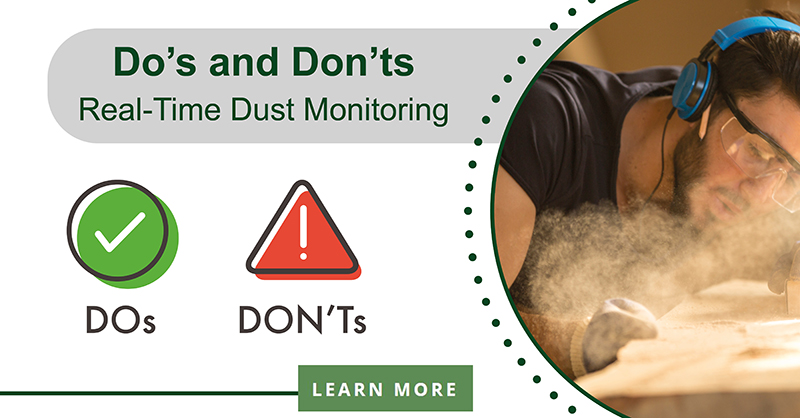Casella UK
Wolseley Rd, Kempston,Bedford MK42 7JY
+44(0)1234844100
info@casellasolutions.com

The long-standing method of sampling air in a workplace to assess exposure to harmful dust has been with an air sampling pump attached to a worker. Air is sampled onto a filter which can then be weighed or further analysed to determine the concentration of harmful substances. It seems somewhat archaic in modern times though we need to often sample something for a whole shift, then, wait to get the results in order to know an individual’s exposure. Of course, real-time dust measurement devices have been around for a long while, and more are coming available on the market. These can be handheld devices or bodily worn, although bodily worn devices still tend to be on the bulky side. Having real-time data though is a massive advantage, amongst other things to see how exposures varied throughout the day. It is however really important to understand real-time instruments to avoid errors when estimating exposure. Many instruments use the interaction of dust particles with light as a means of measuring the dust levels, but the interaction of dust with light varies with the type of dust, so it means real-time dust meters are to a varying degree indicative.
So where does this leave real-time monitors? They are very powerful at giving relative amounts of dust in real-time. For example, measuring after control measures have been implemented showing dust levels have halved will also show that exposure in that area to the dust would in general be halved, regardless of the absolute levels. To understand how real-time instruments should be used, let’s look at some ‘Do’s and Don’ts’.
Use them for walk-through surveys – Real-time handheld instruments are great to walk through a factory or site and use the display to find out where the problem areas are by seeing how dust levels change. Then more in-depth investigation can be done in those areas or control measures implemented as needed.
See how exposure varies through the day – Sampling dusty air onto a filter with a pump will provide the average exposure, but that doesn’t mean the actual exposure is consistent through the day. The process may produce large spikes in dust levels that will be significant contributions to exposure. Knowing when these happen using a real-time monitor, either personally worn or left in an area, can be very useful. It will allow you to know what part of the process is an issue and therefore control measures can be focussed accordingly, saving time and probably significant money.
Check on control measures – If you know you have an issue with dust, then control measures of some form will be required. Using the hierarchy of control, if risks can’t be eliminated often Local Exhaust Ventilation (LEV) is required. Real-time instruments are great for seeing if controls are effective. Measure levels before controls are in place and then measure afterward will show how effective the controls have been, and to see if more action is required.
‘Calibrate’ to a specific dust type – Some real-time instruments can collect a sample on a filter at the same time as the real-time measurement. It's, therefore, possible to correct real-time results in accordance with a more accurate gravimetrically collected sample.
Use them as a training tool – An often-underutilized method of using real-time instruments is as a visual aid. Talking with employees about exposure limits and using real-time instruments to show how activities or methods affect exposure can be very powerful.
Check daily variations – Real-time instruments can fill the gaps between when gravimetric air sampling is done. If someone reports an area being particularly dusty, checks can be made, is an LEV filter getting blocked? If a process needs to be altered, make some measurements with a real-time instrument straight away to check possible effects of exposure.
Rely on them for personal exposure assessment – As described above real-time units are indicative and real-time measurements are not measurements required to comply with legislation, which is where personal sampling with air sampling pumps is vital.
Make assumptions on size fractions – Exposure limits are set around inhalable and respirable size fractions. Real-time instruments are often designed or optimised around respirable size fractions. They cannot measure all size fractions well and don’t measure all the way up to the larger particle sizes that fit into the inhalable range of sizes. Take the time to understand the technical limitations of whatever real-time instrument is being used.
Ignore routine maintenance – Most measurement instrumentation in use for occupational or safety measurements, such as gas detectors, needs regular calibration, and real-time dust measurements are no different. Measurement drift or loss of sensitivity can occur and you need to be confident that a few years after you have purchased the instrument results can still be relied on. Pick a real-time unit that when purchased comes with a calibration certificate against a known dust type and can be calibrated in the field.
Measure for toxic dust components – Measuring in a foundry will mean the dust in the air could have components of metals such as chromium, which in itself has a very low exposure limit. Likewise, in construction levels of respirable crystalline silica (RCS) varies drastically in construction material. Therefore, measuring with a real-time instrument cannot give accurate measurements of any subcomponents of dust. This is where a sample of the dust on a filter analysed by a laboratory is vital to give the concentration of the components in question, which can then be used to calculate exposure over the working day.
In conclusion, real-time instruments are powerful and of course useful in giving information, but understanding the technology used and where traditional air sampling with a pump is necessary will ensure an accurate measure of exposure.